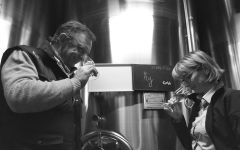Gosset Grande Reserve (375ML half-bottle)
- Decanter
-
Wine
Spectator -
Robert
Parker -
Wine &
Spirits -
Wine
Enthusiast -
Connoisseurs'
Guide -
Jeb
Dunnuck


Product Details
Your Rating
Somm Note
Winemaker Notes
Professional Ratings
-
Decanter
The nose opens with the fresh ripeness of yellow apple and highlights of Granny Smith. It has beautifully subtle autolysis on the palate, deepening into notes of creamy apple crumble, Golden Delicious and Mirabelle plum, while remaining utterly strait-laced. Elegance, length and absolute freshness are inherent and quietly convincing.
-
Wine Spectator
A tightly knit Champagne, backed by racy acidity, this is fresh and harmonious, with a finely detailed mousse and a delicate range of black raspberry, pickled ginger and chalk flavors, offering a touch of salted almond that echoes on the finish. Drink now through 2024.
-
Robert Parker's Wine Advocate
Aromas of crips orchard fruit, pear and apricot, mingled with hints of fresh bread and pastry, introduce the latest release of Gosset's NV Brut Grande Réserve, a medium to full-bodied, fleshy but incisive wine that's deceptively generous but also structured to reward some bottle age.
-
Wine & Spirits
There's refreshing cut to this rich Champagne, melding crisp Asian pear and gooseberry flavors with scents of green tea and caramel. Bright notes of white roses place it with nigiri sushi.
-
Wine Enthusiast
This is one of my favorite nonvintage Champagnes, rich and fresh at the same time, with a serious character that reminds you that great Champagne is a wine as well as bubbles. Complex, weighty and delicious, this is a Champagne that should be enjoyed with food.
-
Connoisseurs' Guide
In too many of the wines reviewed here, those with special denominations and higher prices have failed to share why they are more costly. Not so, this wine. Its extra notes of baked bread are layered comfortably on top of crisp, vital, somewhat austere but always energetic fruit in the nose, and it follows with a fine-grained, pinpointy mousse and older, yet solid and continuous flavors. We liked both Gosset efforts and applaud the value they offer.
-
Jeb Dunnuck
The NV Grande Reserve Brut, which is 45% Chardonnay, 45% Pinot Noir, and the rest Pinot Meunier and 8 g/l dosage, is lifted with tropical and citrus fruit including lychee, orange blossom, and lime. Juicy and medium-bodied, with tangerine and mango, it is a solid entry to the range. Best after 2022.









Founded in Aÿ in 1584 by Pierre Gosset, Champagne Gosset is the oldest wine house in Champagne. For more than four centuries, the family has preserved its house style, a true reflection of the terroir; a textured wine that shows purity, precision and persistence.
Champagne Gosset’s reputation for quality starts in the vineyard, where it sources over 200 unique lots of grapes almost entirely from premier cru and grand cru vineyards in the Côte des Blancs, Grande Vallée de la Marne and Montagne de Reims. Long-term relationships with growers that date back several generations, allow the winemaking team to direct activity in the vineyards.
Champagne Gosset’s winemaking utilizes all the grapes and terroir have to offer and minimizes other inputs. Gosset carefully avoids malolactic fermentation, thus preserving the malic acid present in the grapes. Grower lots are kept separate until it is time to blend the cuvées, and vinification temperatures are managed carefully to preserve delicate aromatics. During assemblage, all the lots are tasted blind – there are no recipes. Similarly, dosage for each lot is selected during blind trials. Non-vintage wines are cellared for at least three years, vintage wines at least seven and 10 for the CELEBRIS cuvées.
After 17 generations, Champagne Gosset’s philosophy continues to produce dynamic, age-worthy cuvées.

A term typically reserved for Champagne and Sparkling Wines, non-vintage or simply “NV” on a label indicates a blend of finished wines from different vintages (years of harvest). To make non-vintage Champagne, typically the current year’s harvest (in other words, the current vintage) forms the base of the blend. Finished wines from previous years, called “vins de reserve” are blended in at approximately 10-50% of the total volume in order to achieve the flavor, complexity, body and acidity for the desired house style. A tiny proportion of Champagnes are made from a single vintage.
There are also some very large production still wines that may not claim one particular vintage. This would be at the discretion of the winemaker’s goals for character of the final wine.

Associated with luxury, celebration, and romance, the region, Champagne, is home to the world’s most prized sparkling wine. In order to bear the label, ‘Champagne’, a sparkling wine must originate from this northeastern region of France—called Champagne—and adhere to strict quality standards. Made up of the three towns Reims, Épernay, and Aÿ, it was here that the traditional method of sparkling wine production was both invented and perfected, birthing a winemaking technique as well as a flavor profile that is now emulated worldwide.
Well-drained, limestone and chalky soil defines much of the region, which lend a mineral component to its wines. Champagne’s cold, continental climate promotes ample acidity in its grapes but weather differences from year to year can create significant variation between vintages. While vintage Champagnes are produced in exceptional years, non-vintage cuvées are produced annually from a blend of several years in order to produce Champagnes that maintain a consistent house style.
With nearly negligible exceptions, . These can be blended together or bottled as individual varietal Champagnes, depending on the final style of wine desired. Chardonnay, the only white variety, contributes freshness, elegance, lively acidity and notes of citrus, orchard fruit and white flowers. Pinot Noir and its relative Pinot Meunier, provide the backbone to many blends, adding structure, body and supple red fruit flavors. Wines with a large proportion of Pinot Meunier will be ready to drink earlier, while Pinot Noir contributes to longevity. Whether it is white or rosé, most Champagne is made from a blend of red and white grapes—and uniquely, rosé is often produce by blending together red and white wine. A Champagne made exclusively from Chardonnay will be labeled as ‘blanc de blancs,’ while ones comprised of only red grapes are called ‘blanc de noirs.’
